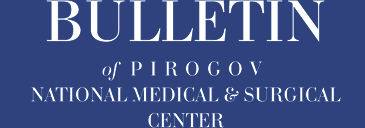Authors
Petrachkov D.V., Shabalina K.N., Sidamonidze A.L., Hanova A.N., Fedoruk N.A.
M.M. Krasnov Research Institute of Eye Diseases, Moscow
Abstract
Relevance: Full– thickness macular hole (FTMH) is a pathology of the vitreoretinal interface, which is characterized by a full-layered defect of the neuroepithelium in the foveolar zone. With large-diameter FTMH, standard surgical tactics can achieve anatomical success in only 50-73.3% of surgical procedures. The task of developing a method for the surgical treatment of large-diameter CMP with the possibility of evaluating its closure intraoperatively is an urgent task and may be of interest for the development of ophthalmic surgery.
Purpose: to evaluate the anatomical and functional results of large FTMH surgery using the proposed technique in the long-term postoperative period.
Materials and methods. A randomized trial was conducted on two comparable groups. The patients underwent a comprehensive ophthalmological examination, including visual acuity, intraocular pressure, ophthalmoscopy, and optical coherence tomography of the retina before surgery, 1, 6, and 12 months after surgery. Surgical treatment of FTMH was performed in both groups, in the first group, the stage of closure of the FTMH was carried out according to the proposed method, in the second group, autologous conditioned plasma was applied to the rupture surface with subsequent exposure to close the FTMH.
Results and discussion: In the control group, 4 cases of FTMH recurrence were recorded in the postoperative period for up to 1 month after surgery. The U-shaped closure pattern was more often observed in the first group, while the V-shaped closure pattern was more often observed in the second group. Visual acuity 12 months after surgery was higher on average in patients in the first group (p = 0.05).
Conclusions: The developed technique for closing the FTMH has demonstrated a significant reduction in the risk of recurrence in the postoperative period. The use of this surgical approach ensures the achievement of a U–shaped closure of the FTMH, as well as the achievement of positive dynamics of functional outcomes, resulting in higher rates of BCVA. This technique is promising and requires further research.
Keywords: vitreoretinal surgery, macular hole, optical coherence tomography, autologous conditioned plasma.
References
1. Zhao PP, Wang S, Liu N, Shu ZM, Zhao JS. A Review of Surgical Outcomes and Advances for Macular Holes. J Ophthalmol. 2018 Apr 18;2018:7389412. doi: 10.1155/2018/7389412.
2. Susini A, Gastaud P. Ces trous maculaires qu’il vaut mieux ne pas opérer.. [Macular holes that should not be operated]. J Fr Ophtalmol. 2008 Feb;31(2):214-20. French. doi: 10.1016/s0181-5512(08)70359-0.
3. Samoilov A.N., Fazleeva G.A., Khaybrakhmanov T.R. Retrospective analysis of the results of surgical treatment of large-diameter macular tears. Kazan Medical Journal. 2018;99(2):341–344.
4. Arsyutov D.G., Andreev A.N. Surgical approach for treating large and giant macular rupture. Point of view. East-West. Tochka zrenija. Vostok – Zapad. 2016;2:97–98 (In Russ.)
5. D. V. Petrachkov_ P. A. Zamickii_ A. V. Zolotarev. Rol sblijeniya kraev skvoznogo makulyarnogo razriva pri ispolzovanii metodiki perevernutogo loskuta. Sovremennie tehnologii v oftalmologii. 2017; № 1;221-225.
6. Petrachkov D.V., Alkharki L., Matyushchenko A.G., Filippov V.M., Dudieva F.K. Comparison of Early Results of Treatment of Large Macular Tears Using Different Surgical Techniques. Ophthalmology. 2021;18(3S):681–687.
7. Fayzrakhmanov R.R. A Method for Closing Macular Tears with Partial Preservation of the Internal Boundary Membrane. Vestnik Oftalmologii. 2020;136(1): 73 79. https://doi.org/ 10.17116/oftalma202013601173.
8. Inoue M, Itoh Y, Koto T, Kurimori HY, Hirakata A. Intraoperative OCT Findings May Predict Postoperative Visual Outcome in Eyes with Idiopathic Macular Hole. Ophthalmol Retina. 2019 Nov;3(11):962-970. https://doi.org/10.1016/j.oret.2019.05.022
9. Nishitsuka K, Nishi K, Namba H, Kaneko Y, Yamashita H. Intraoperative Observation of a Macular Holes Using Optical Coherence Tomography. Clin Optom (Auckl). 2021 Apr 14;13:113-118. https://doi.org/10.2147/OPTO.S305927
10. Yusef Yu., Petrachkov D.V., Shabalina K.N., Alharki L., Baryshev K.V., Korobov E.N., Matyushhennko A.G., Sidamonidze A.L., Filippov V.M., Said N.Yu. Sposob hirurgicheskogo lechenija skvoznogo makuljarnogo razryva. Patent RU 2797540 C1. (In Russ.)
11. Amr Mohammed Elsayed Abdelkader, Mohamed Nader Roshdy El Metwaly, Mohamed Ahmed Khalaf, Amal Moustafa El Bendary, Amr Mohamed Hassan El-Kannishy. Vitrectomy for idiopathic macular hole: outcomes and complications. Benha Medical Journal. 2015;32(2):107. https://doi.org/10.4103/1110-208X.180323.


